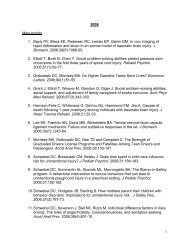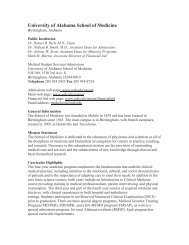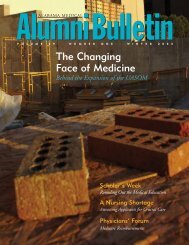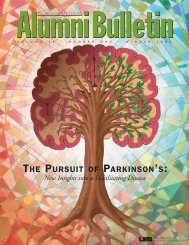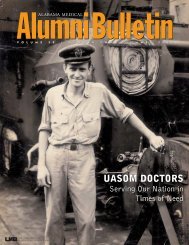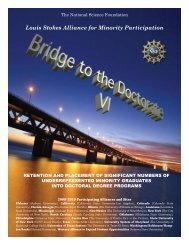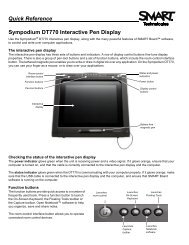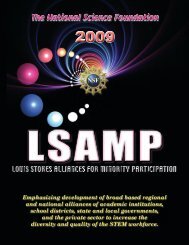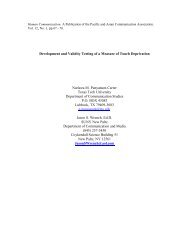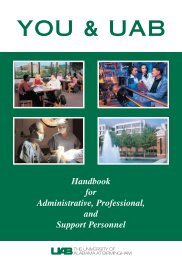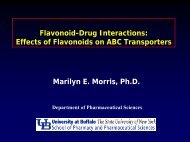How Do I Perform a Lumbar Puncture and Analyze the Results to ...
How Do I Perform a Lumbar Puncture and Analyze the Results to ...
How Do I Perform a Lumbar Puncture and Analyze the Results to ...
Create successful ePaper yourself
Turn your PDF publications into a flip-book with our unique Google optimized e-Paper software.
THE RATIONAL<br />
CLINICAL EXAMINATION<br />
CLINICIAN’S CORNER<br />
<strong>How</strong> <strong>Do</strong> I <strong>Perform</strong> a <strong>Lumbar</strong> <strong>Puncture</strong><br />
<strong>and</strong> <strong>Analyze</strong> <strong>the</strong> <strong>Results</strong> <strong>to</strong> Diagnose<br />
Bacterial Meningitis?<br />
Sharon E. Straus, MD, MSc, FRCPC<br />
Kevin E. Thorpe, MMath<br />
Jayna Holroyd-Leduc, MD, FRCPC<br />
PATIENT SCENARIO<br />
A previously healthy 70-year-old<br />
woman presents <strong>to</strong> <strong>the</strong> emergency department<br />
with a 3-day his<strong>to</strong>ry of fever,<br />
confusion, <strong>and</strong> lethargy. She is unable<br />
<strong>to</strong> cooperate with a full physical<br />
examination, but she has neck stiffness<br />
upon neck flexion. Her score on<br />
<strong>the</strong> Glasgow Coma Scale is 13 (eye, 4;<br />
verbal, 4; mo<strong>to</strong>r, 5). The findings from<br />
a chest radiograph <strong>and</strong> urinalysis are<br />
normal. 1 You seek consent from her<br />
husb<strong>and</strong> <strong>to</strong> perform a lumbar puncture<br />
(LP).<br />
Why Is This Diagnostic Procedure<br />
Important?<br />
In a previous Rational Clinical Examination<br />
article, Attia <strong>and</strong> colleagues 1 discussed<br />
<strong>the</strong> above scenario <strong>and</strong> recommended<br />
proceeding <strong>to</strong> LP for definitive<br />
testing of <strong>the</strong> cerebrospinal fluid (CSF).<br />
Cerebrospinal fluid is a clear, colorless<br />
fluid that fills <strong>the</strong> ventricles <strong>and</strong><br />
subarachnoid space surrounding <strong>the</strong><br />
brain <strong>and</strong> spinal cord. 2 <strong>Lumbar</strong> puncture<br />
allows this fluid <strong>to</strong> be sampled,<br />
facilitating <strong>the</strong> diagnosis of various<br />
conditions.<br />
Since it was first described by<br />
Quincke 3 in 1891, <strong>the</strong> LP has become<br />
See also Patient Page.<br />
CME available online at<br />
www.jama.com<br />
Context Diagnostic lumbar punctures (LPs), commonly used <strong>to</strong> rule out meningitis,<br />
are associated with adverse events.<br />
Objective To systematically review <strong>the</strong> evidence about diagnostic LP techniques that<br />
may decrease <strong>the</strong> risk of adverse events <strong>and</strong> <strong>the</strong> evidence about test accuracy of cerebrospinal<br />
fluid (CSF) analysis in adult patients with suspected bacterial meningitis.<br />
Data Sources We searched <strong>the</strong> Cochrane Library, MEDLINE (using Ovid <strong>and</strong> PubMed)<br />
from 1966 <strong>to</strong> January 2006 <strong>and</strong> EMBASE from 1980 <strong>to</strong> January 2006 without language<br />
restrictions <strong>to</strong> identify relevant studies <strong>and</strong> identified o<strong>the</strong>rs from <strong>the</strong> bibliographies<br />
of retrieved articles.<br />
Study Selection We included r<strong>and</strong>omized trials of patients aged 18 years or older<br />
undergoing interventions <strong>to</strong> facilitate a successful diagnostic LP or <strong>to</strong> potentially reduce<br />
adverse events. Studies assessing <strong>the</strong> accuracy of biochemical analysis of <strong>the</strong> CSF<br />
for possible bacterial meningitis were also identified.<br />
Data Extraction Two investiga<strong>to</strong>rs independently appraised study quality <strong>and</strong> extracted<br />
relevant data. For studies of <strong>the</strong> LP technique, data on <strong>the</strong> intervention <strong>and</strong><br />
<strong>the</strong> outcome were extracted. For studies of <strong>the</strong> labora<strong>to</strong>ry diagnosis of bacterial meningitis,<br />
data on <strong>the</strong> reference st<strong>and</strong>ard <strong>and</strong> test accuracy were extracted.<br />
Data Syn<strong>the</strong>sis We found 15 r<strong>and</strong>omized trials. A r<strong>and</strong>om-effects model was used<br />
for quantitative syn<strong>the</strong>sis. Five studies of 587 patients compared atraumatic needles with<br />
st<strong>and</strong>ard needles <strong>and</strong> found a nonsignificant decrease in <strong>the</strong> odds of headache with an<br />
atraumatic needle (absolute risk reduction [ARR], 12.3%; 95% confidence interval [CI],<br />
−1.72% <strong>to</strong> 26.2%). Reinsertion of <strong>the</strong> stylet before needle removal decreased <strong>the</strong> risk of<br />
headache (ARR, 11.3%; 95% CI, 6.50%-16.2%). The combined results from 4 studies<br />
of 717 patients showed a nonsignificant decrease in headache in patients who were mobilized<br />
after LP (ARR, 2.9%; 95% CI, −3.4 <strong>to</strong> 9.3%). Four studies on <strong>the</strong> accuracy of<br />
biochemical analysis of CSF in patients with suspected meningitis met inclusion criteria. A<br />
CSF–blood glucose ratio of 0.4 or less (likelihood ratio [LR], 18; 95% CI, 12-27]), CSF<br />
white blood cell count of 500/µL or higher (LR, 15; 95% CI, 10-22), <strong>and</strong> CSF lactate<br />
level of 31.53 mg/dL or more (3.5 mmol/L; LR, 21; 95% CI, 14-32) accurately diagnosed<br />
bacterial meningitis.<br />
Conclusions These data suggest that small-gauge, atraumatic needles may decrease<br />
<strong>the</strong> risk of headache after diagnostic LP. Reinsertion of <strong>the</strong> stylet before needle<br />
removal should occur <strong>and</strong> patients do not require bed rest after <strong>the</strong> procedure. Future<br />
research should focus on evaluating interventions <strong>to</strong> optimize <strong>the</strong> success of a diagnostic<br />
LP <strong>and</strong> <strong>to</strong> enhance training in procedural skills.<br />
JAMA. 2006;296:2012-2022<br />
www.jama.com<br />
Author Affiliations: Division of General Internal Medicine,UniversityofCalgary,Alberta(DrStraus);Knowledge<br />
Translation Program, University of Toron<strong>to</strong>/St Mi-<br />
chael’sHospital,Toron<strong>to</strong>,Ontario(DrsStraus<strong>and</strong>Holroyd-<br />
Leduc <strong>and</strong> Mr Thorpe); Department of Public Health<br />
Sciences, University of Toron<strong>to</strong>, Toron<strong>to</strong>, Ontario (Mr<br />
Thorpe); Division of General Internal Medicine, UniversityHealthNetwork,Toron<strong>to</strong>,Ontario(DrHolroyd-Leduc).<br />
Corresponding Author: Sharon E. Straus, MD, MSc,<br />
FRCPC, Foothills Medical Centre 1403 29th St NW, Calgary,<br />
Canada AB T2N 2T9 (sharon.straus@u<strong>to</strong>ron<strong>to</strong>.ca).<br />
The Rational Clinical Examination Section Edi<strong>to</strong>rs:<br />
David L. Simel, MD, MHS, Durham Veterans Affairs<br />
Medical Center <strong>and</strong> Duke University Medical Center,<br />
Durham, NC; Drummond Rennie, MD, Deputy Edi<strong>to</strong>r,<br />
JAMA.<br />
2012 JAMA, Oc<strong>to</strong>ber 25, 2006—Vol 296, No. 16 (Reprinted) ©2006 American Medical Association. All rights reserved.<br />
<strong>Do</strong>wnloaded from www.jama.com at University of Alabama-Birmingham, on November 8, 2006
DIAGNOSING BACTERIAL MENINGITIS BY LUMBAR PUNCTURE<br />
an important diagnostic <strong>to</strong>ol, particularly<br />
when considering <strong>the</strong> diagnosis of<br />
meningitis. Evaluation of CSF can help<br />
establish a diagnosis <strong>and</strong> guide antimicrobial<br />
<strong>the</strong>rapy. Less commonly, LP is<br />
used as part of <strong>the</strong> diagnostic workup<br />
of patients with suspected subarachnoid<br />
hemorrhage, demyelinating disease,<br />
<strong>and</strong> lep<strong>to</strong>meningeal metastasis. 4,5<br />
What Adverse Events Can Result<br />
From an LP?<br />
Bier was <strong>the</strong> first <strong>to</strong> report <strong>the</strong> technique<br />
of spinal anes<strong>the</strong>sia <strong>and</strong> also provided<br />
(through personal experience!)<br />
<strong>the</strong> first description of post-LP headache.<br />
6 Headache <strong>and</strong> backache are <strong>the</strong><br />
most frequently reported adverse events<br />
associated with LP. Headache can occur<br />
in up <strong>to</strong> 60% of patients who undergo<br />
<strong>the</strong> procedure, although estimates<br />
vary due <strong>to</strong> differences in<br />
inclusion criteria <strong>and</strong> definitions of<br />
headache. 7-9 Headache can be severe <strong>and</strong><br />
debilitating 10 <strong>and</strong> is believed <strong>to</strong> occur<br />
because of CSF leakage through <strong>the</strong> dural<br />
puncture site. 11 Backache is less common<br />
but can occur in up <strong>to</strong> 40% of patients<br />
following LP. 7 Rare adverse events<br />
include cerebral herniation, intracranial<br />
subdural hemorrhage, spinal epidural<br />
hemorrhage, <strong>and</strong> infection. 11<br />
What Are <strong>the</strong> Contraindications<br />
<strong>to</strong> <strong>Perform</strong>ing an LP?<br />
Clinicians often worry that an undetected<br />
mass lesion or ventricular obstruction<br />
causing raised intracranial pressure<br />
pose risks for cerebral herniation<br />
following an LP. 4 <strong>How</strong>ever, no conclusive<br />
evidence supports that <strong>the</strong> risk can<br />
be reduced with universal neuroimaging<br />
prior <strong>to</strong> LP. Instead of universal neuroimaging,<br />
clinicians can use <strong>the</strong> clinical<br />
examination <strong>to</strong> guide <strong>the</strong> decision <strong>to</strong><br />
obtain neuroimaging. In a prospective<br />
study, 113 patients were examined by<br />
internal medicine residents (overseen by<br />
emergency physicians) prior <strong>to</strong> undergoing<br />
computed <strong>to</strong>mography (CT) of <strong>the</strong><br />
brain <strong>and</strong> subsequent LP. 12 The median<br />
age of patients was 42 years, 36%<br />
were immunocompromised, <strong>and</strong> 46% of<br />
patients had altered mentation. Altered<br />
mentation (likelihood ratio [LR], 2.2;<br />
95% confidence interval [CI], 1.5-3.2),<br />
focal neurological finding (LR, 4.3; 95%<br />
CI, 1.9-10), <strong>and</strong> papilledema (LR, 11;<br />
95% CI, 1.1-115) increased <strong>the</strong> likelihood<br />
of an intracranial lesion. 12 Overall<br />
clinical impression (not defined in <strong>the</strong><br />
study) was able <strong>to</strong> identify patients with<br />
a CT-defined contraindication <strong>to</strong> LP (LR,<br />
19; 95% CI, 4.8-43). In a second prospective<br />
study of 301 patients with suspected<br />
meningitis, 235 underwent a CT<br />
scan prior <strong>to</strong> LP. 13 The mean age of patients<br />
was 40 years (16% were 60<br />
years), 25% were immunocompromised,<br />
<strong>and</strong> 27% of patients had a Charlson<br />
comorbidity score of more than 1.<br />
Patients were assessed clinically by an<br />
emergency physician or general internist.<br />
The absence of a number of clinical<br />
features at baseline was able <strong>to</strong> identify<br />
those who were unlikely <strong>to</strong> have an<br />
abnormal CT result (LR, 0.10; 95% CI,<br />
0.03-0.31). The absence of all of <strong>the</strong> following<br />
baseline characteristics was associated<br />
with this low LR: age 60 years<br />
or older, immunocompromised state,<br />
his<strong>to</strong>ry of central nervous system disease,<br />
<strong>and</strong> seizure within 1 week of presentation.<br />
In addition, <strong>the</strong>re could be<br />
none of <strong>the</strong> following physical examination<br />
findings: abnormal level of consciousness,<br />
inability <strong>to</strong> answer 2 questions<br />
correctly, inability <strong>to</strong> follow 2<br />
consecutive comm<strong>and</strong>s correctly, gaze<br />
palsy, abnormal visual fields, facial palsy,<br />
arm drift, leg drift, <strong>and</strong> abnormal language.<br />
Using <strong>the</strong> pretest probability of<br />
an abnormal CT finding from this study<br />
(23.8%), <strong>the</strong> absence of all of <strong>the</strong>se features<br />
would reduce <strong>the</strong> probability of an<br />
abnormal finding <strong>to</strong> 3.0%. The findings<br />
from <strong>the</strong>se 2 studies have not been<br />
validated prospectively in o<strong>the</strong>r independent<br />
populations.<br />
Local infection at <strong>the</strong> puncture site<br />
is also a contraindication <strong>to</strong> completing<br />
an LP but this occurs infrequently.<br />
4 More frequently, clinicians are<br />
concerned about coagulation defects<br />
<strong>and</strong> use of anticoagulants, which may<br />
increase <strong>the</strong> risk of epidural hemorrhage.<br />
In 1 study of post-LP complications,<br />
outcomes were compared in 166<br />
patients receiving anticoagulation with<br />
171 of those who were not receiving<br />
<strong>the</strong>rapy. There was a trend <strong>to</strong>ward increased<br />
risk of paraparesis in <strong>the</strong> anticoagulated<br />
patients (relative risk, 11.0;<br />
95% CI, 0.60-199) with 5 patients in<br />
<strong>the</strong> anticoagulation group experiencing<br />
an adverse event compared with<br />
none in <strong>the</strong> control group. In all patients<br />
who experienced paraparesis, anticoagulation<br />
had been started within<br />
an hour of <strong>the</strong> procedure. 14 A survey of<br />
246 pediatric <strong>and</strong> adult neurology department<br />
chairpersons <strong>and</strong> residency<br />
program direc<strong>to</strong>rs found that 45% of respondents<br />
ordered platelet <strong>and</strong> anticoagulation<br />
studies prior <strong>to</strong> LP. 15 We were<br />
unable <strong>to</strong> find any data evaluating <strong>the</strong><br />
safety of LP in patients with low platelet<br />
counts. In a case series of 66 patients<br />
with acute leukemia, patients<br />
with lower platelet counts (5010 3 /<br />
µL) had higher risk of a traumatic procedure<br />
as defined by <strong>the</strong> presence in <strong>the</strong><br />
CSF of more than 500 red blood cells<br />
per high-powered field. 16 <strong>How</strong>ever, LPs<br />
were not performed in patients with<br />
platelet counts lower than 2010 3 /µL<br />
in this study.<br />
We conducted a systematic review <strong>to</strong><br />
identify studies of interventions that enhance<br />
<strong>the</strong> success of an LP <strong>and</strong> that minimize<br />
adverse events. Based on review of<br />
<strong>the</strong> evidence <strong>and</strong> its integration with expert<br />
opinion, we provide a bestpractice<br />
approach for LP in adults. Because<br />
a clinician’s interpretation of <strong>the</strong><br />
LP results is tightly coupled <strong>to</strong> <strong>the</strong> clinical<br />
examination findings, we also reviewed<br />
<strong>the</strong> literature that addresses <strong>the</strong><br />
accuracy of common CSF tests for bacterial<br />
meningitis. Tests for diagnosing viral<br />
meningitis were not included in this<br />
review. Although <strong>the</strong>re are o<strong>the</strong>r indications<br />
for LP <strong>and</strong> CSF analysis, this article<br />
focuses on CSF analysis for suspected<br />
bacterial meningitis because it<br />
requires immediate action <strong>and</strong> is one of<br />
<strong>the</strong> most common diagnoses that generalist<br />
physicians consider when performing<br />
this procedure.<br />
METHODS<br />
Searches of <strong>the</strong> Cochrane Library,<br />
MEDLINE (using Ovid <strong>and</strong> PubMed)<br />
from 1966 <strong>to</strong> January 2006, <strong>and</strong><br />
EMBASE from 1980 <strong>to</strong> January 2006<br />
©2006 American Medical Association. All rights reserved. (Reprinted) JAMA, Oc<strong>to</strong>ber 25, 2006—Vol 296, No. 16 2013<br />
<strong>Do</strong>wnloaded from www.jama.com at University of Alabama-Birmingham, on November 8, 2006
DIAGNOSING BACTERIAL MENINGITIS BY LUMBAR PUNCTURE<br />
were completed <strong>to</strong> identify relevant<br />
studies. The search strategy used <strong>the</strong><br />
terms lumbar puncture, spinal puncture,<br />
dural puncture, headache, headach*,<br />
spinal needle*, cerebrospinal fluid,<br />
spinal fluid, <strong>and</strong> meningitis. Intervention<br />
studies were limited <strong>to</strong> r<strong>and</strong>omized<br />
controlled trials using <strong>the</strong> terms<br />
r<strong>and</strong>omized controlled trial, controlled<br />
clinical trial, clinical trial, r<strong>and</strong>om allocation,<br />
<strong>and</strong> r<strong>and</strong>om*. No language restrictions<br />
were used. Additional articles<br />
were identified from searching <strong>the</strong><br />
bibliographies of retrieved articles. Details<br />
on <strong>the</strong> search strategies are available<br />
on request.<br />
R<strong>and</strong>omized trials of patients (18<br />
years) undergoing interventions <strong>to</strong> potentially<br />
reduce headache <strong>and</strong> backache<br />
at <strong>the</strong> time of diagnostic LP were<br />
included. <strong>How</strong>ever, if no r<strong>and</strong>omized<br />
studies of a particular intervention were<br />
identified, studies of lower quality—<br />
including cohort, case-control, <strong>and</strong> case<br />
series—were retrieved. Studies assessing<br />
patients undergoing LP during spinal<br />
anes<strong>the</strong>sia or myelography were excluded<br />
because <strong>the</strong>se procedures are<br />
clinically different from a diagnostic LP.<br />
Smaller amounts of fluid are removed<br />
during spinal anes<strong>the</strong>sia <strong>and</strong> myelography<br />
than with diagnostic LP <strong>and</strong> fluids<br />
are inserted during <strong>the</strong>se o<strong>the</strong>r procedures.<br />
Moreover, <strong>the</strong> risk of headache<br />
is greater with diagnostic LP than with<br />
spinal anes<strong>the</strong>sia. 7 Interventions of interest<br />
included those that could be used<br />
at <strong>the</strong> time of LP, such as immediate mobilization,<br />
atraumatic needles, <strong>and</strong> reinsertion<br />
of <strong>the</strong> stylet. We also attempted<br />
<strong>to</strong> identify studies that assessed<br />
<strong>the</strong> impact of positioning of <strong>the</strong> patient<br />
<strong>and</strong> experience of <strong>the</strong> opera<strong>to</strong>r. The outcome<br />
of interest included headache occurring<br />
up <strong>to</strong> 7 days after LP.<br />
To examine <strong>the</strong> accuracy of CSF<br />
analysis in patients with suspected acute<br />
bacterial meningitis, we included studies<br />
of predominantly adult populations<br />
<strong>and</strong> those that described use of an<br />
appropriate reference st<strong>and</strong>ard (eg, CSF<br />
culture or bacterial antigen) in all patients.<br />
In addition, primary data or appropriate<br />
summary statistics had <strong>to</strong> be<br />
available in <strong>the</strong> studies.<br />
Two reviewers (S.E.S. <strong>and</strong> J.M.<br />
H-L.) independently reviewed <strong>and</strong> selected<br />
relevant publications that met <strong>the</strong><br />
inclusion criteria from <strong>the</strong> search results.<br />
Disagreements were resolved by<br />
consensus. In cases of doubt, full-text<br />
articles were retrieved for review <strong>and</strong><br />
discussion. Full-text articles of all abstracts<br />
that met <strong>the</strong> inclusion criteria<br />
were retrieved.<br />
The 2 reviewers independently read<br />
all full-text articles <strong>to</strong> confirm that inclusion<br />
criteria were met. The investiga<strong>to</strong>rs<br />
also assessed study quality. For<br />
intervention studies, a specially designed<br />
data collection form was used <strong>to</strong><br />
extract data on study quality including<br />
<strong>the</strong> method of r<strong>and</strong>omization, <strong>the</strong><br />
presence of blinding, <strong>and</strong> <strong>the</strong> method<br />
used for outcome assessment. Data were<br />
also extracted on <strong>the</strong> intervention <strong>and</strong><br />
<strong>the</strong> dicho<strong>to</strong>mous outcome variable of<br />
post-LP headache. The minimum inclusion<br />
criteria for r<strong>and</strong>omized studies<br />
of interventions <strong>to</strong> prevent adverse<br />
events were <strong>the</strong> description of r<strong>and</strong>omization<br />
<strong>and</strong> <strong>the</strong> ability <strong>to</strong> extract relevant<br />
patient data. For studies of test<br />
accuracy, data were extracted on <strong>the</strong> reference<br />
st<strong>and</strong>ard, <strong>the</strong> presence of blinding,<br />
<strong>the</strong> index test, <strong>and</strong> <strong>the</strong> population<br />
characteristics. Minimum inclusion criteria<br />
for studies of test accuracy in patients<br />
with suspected meningitis were<br />
<strong>the</strong> completion of an appropriate reference<br />
st<strong>and</strong>ard in all patients <strong>and</strong> <strong>the</strong><br />
ability <strong>to</strong> extract relevant data. Differences<br />
in assessment by <strong>the</strong> reviewers<br />
were resolved through discussion, <strong>and</strong><br />
a third investiga<strong>to</strong>r (K.E.T.) was available<br />
if necessary.<br />
For <strong>the</strong> intervention studies, statistical<br />
heterogeneity was assessed using<br />
<strong>the</strong> method described by Woolf. 17 A<br />
r<strong>and</strong>om-effects model (DerSimonian<br />
<strong>and</strong> Laird) was used for quantitative<br />
data. For <strong>the</strong> studies of test accuracy,<br />
LRs were calculated using <strong>the</strong> r<strong>and</strong>omeffects<br />
model. Statistical analyses were<br />
conducted using R: A Language <strong>and</strong> Environment<br />
for Statistical Computing <strong>and</strong><br />
<strong>the</strong> rmeta contributed package. R is an<br />
open-source dialect of <strong>the</strong> S language<br />
(S was developed by AT&T) that is<br />
maintained by a core team (http://www<br />
.r-project.org). A 2-tailed P value of<br />
.05 was considered statistically significant.<br />
RESULTS<br />
We found 537 citations of potential interventions<br />
<strong>to</strong> optimize LP technique.<br />
Review of <strong>the</strong>se led <strong>to</strong> retrieval of 22<br />
full-text articles for assessment, 15 of<br />
which were subsequently identified for<br />
inclusion. Reasons for excluding trials<br />
were lack of r<strong>and</strong>omization (5 studies<br />
18-22 ), repeat publication (1 study 23 ),<br />
<strong>and</strong> inability <strong>to</strong> obtain outcomes data<br />
(1 study 24 ). Studies were categorized by<br />
intervention including needle type,<br />
needle size, reinsertion of stylet, mobilization<br />
after LP, <strong>and</strong> use of supplemental<br />
fluids. No studies of o<strong>the</strong>r interventions—such<br />
as positioning of <strong>the</strong><br />
patient during LP, direction of bevel,<br />
volume of CSF removed, or prophylactic<br />
use of an epidural blood patch—<br />
met <strong>the</strong> inclusion criteria.<br />
Description of Studies<br />
Fifteen r<strong>and</strong>omized trials were identified<br />
with sample sizes ranging from 44<br />
<strong>to</strong> 600 people. Eight studies had sample<br />
sizes of 100 patients or fewer.<br />
<strong>Perform</strong>ing <strong>the</strong> Procedure<br />
Experience of Opera<strong>to</strong>r. We were unable<br />
<strong>to</strong> identify any r<strong>and</strong>omized studies<br />
that evaluated <strong>the</strong> impact of <strong>the</strong> experience<br />
of <strong>the</strong> clinician performing LPs<br />
on clinical outcomes. Some studies we<br />
identified included experienced neurologists,<br />
23 whereas o<strong>the</strong>rs involved students<br />
under <strong>the</strong> supervision of physicians.<br />
25 In a case series of LPs performed<br />
at an urban university-affiliated hospital,<br />
<strong>the</strong> incidence of traumatic LP was<br />
15% using a definition of more than 400<br />
red blood cells per high-powered field<br />
<strong>and</strong> 10% using a definition of more than<br />
1000 red blood cells. 26 <strong>How</strong>ever, <strong>the</strong><br />
level of training <strong>and</strong> specialty of all physicians<br />
were not recorded. One retrospective<br />
study compared <strong>the</strong> incidence<br />
of traumatic LP at <strong>the</strong> end of <strong>the</strong><br />
resident academic year when housestaff<br />
are more experienced with that at<br />
<strong>the</strong> start of <strong>the</strong> next year when new<br />
housestaff begin training. Using a cut-<br />
2014 JAMA, Oc<strong>to</strong>ber 25, 2006—Vol 296, No. 16 (Reprinted) ©2006 American Medical Association. All rights reserved.<br />
<strong>Do</strong>wnloaded from www.jama.com at University of Alabama-Birmingham, on November 8, 2006
DIAGNOSING BACTERIAL MENINGITIS BY LUMBAR PUNCTURE<br />
off of 1000 red blood cells/µL, <strong>the</strong>re was<br />
no difference in risk of traumatic LP between<br />
experienced housestaff (14%)<br />
<strong>and</strong> inexperienced housestaff (12%). 27<br />
In a prospective cohort of 501 patients<br />
who underwent LP ei<strong>the</strong>r by a nurse,<br />
physician, resident, or medical student,<br />
<strong>the</strong>re was no significant difference<br />
in <strong>the</strong> risk of post-LP headache<br />
among <strong>the</strong> 3 groups. 28 We found no data<br />
on <strong>the</strong> number of LPs required <strong>to</strong> demonstrate<br />
or maintain proficiency.<br />
Positioning of Patient. We were unable<br />
<strong>to</strong> identify any studies that evaluated<br />
<strong>the</strong> success of LP with different patient<br />
positions or <strong>the</strong> impact of patient<br />
positioning on <strong>the</strong> risk of adverse<br />
events. One study assessed <strong>the</strong> interspinous<br />
distance <strong>to</strong> determine <strong>the</strong> impact<br />
of positioning. Measurement of <strong>the</strong><br />
interspinous distance was conducted in<br />
16 patients who were placed in 3 positions<br />
(lateral recumbent with knees<br />
<strong>to</strong> chest; sitting <strong>and</strong> bent forward over<br />
an adjustable bedside st<strong>and</strong>; <strong>and</strong> sitting<br />
with feet supported <strong>and</strong> chest resting<br />
on <strong>the</strong> knees). 29 The interspinous<br />
distance was greatest when <strong>the</strong> patient<br />
was placed in <strong>the</strong> sitting position with<br />
feet supported.<br />
Needle Choice <strong>and</strong> Number of<br />
Attempts. Five studies with data from<br />
587 patients compared atraumatic<br />
Sprotte or Pajunk needles with st<strong>and</strong>ard<br />
Quincke needles (FIGURE 1) during<br />
diagnostic LP. 30-34 One of <strong>the</strong>se studies<br />
32 described <strong>the</strong> r<strong>and</strong>omization<br />
method <strong>and</strong> 4 studies 30-33 described <strong>the</strong><br />
use of blinded outcomes assessment.<br />
Three studies provided data for intention-<strong>to</strong>-treat<br />
analysis. 30-32<br />
There was a nonsignificant decrease<br />
in <strong>the</strong> risk of headache among patients<br />
who underwent diagnostic LP with an<br />
atraumatic needle (absolute risk reduction<br />
[ARR], 12.3%; 95% CI, −1.72% <strong>to</strong><br />
26.2%]). There was statistically significant<br />
heterogeneity among <strong>the</strong>se trials<br />
( 2 4=13.3, P.01). The heterogeneity appeared<br />
<strong>to</strong> be due primarily <strong>to</strong> <strong>the</strong> small<br />
study (n=61) by Lenaerts <strong>and</strong> colleagues<br />
(FIGURE 2) with only 9 outcome<br />
events. 30 One study 32 included<br />
data on severe headache <strong>and</strong> found this<br />
risk significantly decreased with atraumatic<br />
needles (ARR, 23%; 95% CI, 6%-<br />
40%). There are no data available on<br />
how often an introducer was used with<br />
atraumatic needles or its impact.<br />
Three of <strong>the</strong>se studies, which involved<br />
296 patients, included data on<br />
<strong>the</strong> number of attempts required <strong>to</strong><br />
complete <strong>the</strong> LP when using an atraumatic<br />
needle. 31-33 There was no significant<br />
heterogeneity among <strong>the</strong>se studies<br />
( 2 2=0.46, P =.80). There was a<br />
nonsignificant increase in <strong>the</strong> risk of requiring<br />
2 or more attempts when an<br />
Figure 1. Types of <strong>Lumbar</strong> <strong>Puncture</strong> Needles<br />
Stylet<br />
Atraumatic Needle<br />
Needle<br />
atraumatic needle was used (ARI, 4.9%;<br />
95% CI, −13% <strong>to</strong> 3.4%). 31-33 One study<br />
found an increased risk of requiring 4<br />
attempts with an atraumatic needle<br />
compared with st<strong>and</strong>ard needle (ARI,<br />
14%; 95% CI, 3.1%-25%). 32 This study<br />
also included data on backache <strong>and</strong><br />
found no increased risk with <strong>the</strong> atraumatic<br />
needle (ARR, 7.4%; 95% CI, −12%<br />
<strong>to</strong> 27%) despite requiring more attempts<br />
with an atraumatic needle.<br />
These data on backache <strong>and</strong> number of<br />
attempts required with an atraumatic<br />
St<strong>and</strong>ard Needle<br />
Two types of lumbar puncture needles are available—<strong>the</strong> atraumatic (Sprotte or Pajunk) needle <strong>and</strong> <strong>the</strong> st<strong>and</strong>ard<br />
(Quincke) needle. Ei<strong>the</strong>r <strong>the</strong> 22-gauge or 20-gauge atraumatic needle, with or without an introducer,<br />
can be used for diagnostic lumbar puncture. Use of an atraumatic needle compared with a st<strong>and</strong>ard needle<br />
<strong>and</strong> use of a 26-gauge st<strong>and</strong>ard needle compared with a 22-gauge st<strong>and</strong>ard needle have been shown <strong>to</strong> be<br />
associated with reduced risk of headache after lumbar puncture. 37,38<br />
Figure 2. Atraumatic vs St<strong>and</strong>ard Needles <strong>and</strong> Occurrence of Any Headache<br />
Source<br />
No. of Patients<br />
With Headache/<br />
Total No. of Patients<br />
Atraumatic<br />
Needle<br />
St<strong>and</strong>ard<br />
Needle<br />
Odds Ratio<br />
(95% Confidence Interval)<br />
Kleyweg et al, 33 1998 3/49 16/50 0.14 (0.04-0.51)<br />
Lenaerts et al, 30 1993 7/26 2/35 6.08 (1.14-32.28)<br />
Muller et al, 31 1994 5/50 15/50 0.26 (0.09-0.78)<br />
Strupp et al, 34 2001 14/115 28/115 0.43 (0.21-0.87)<br />
Thomas et al, 32 2000 21/49 31/48 0.41 (0.18-0.93)<br />
Overall 50/289 92/298 0.46 (0.19-1.07)<br />
The size of <strong>the</strong> data markers reflects <strong>the</strong> size of <strong>the</strong> study.<br />
0.10<br />
Atraumatic<br />
Needle<br />
Better<br />
St<strong>and</strong>ard<br />
Needle<br />
Better<br />
1.00<br />
Odds Ratio<br />
10.00<br />
©2006 American Medical Association. All rights reserved. (Reprinted) JAMA, Oc<strong>to</strong>ber 25, 2006—Vol 296, No. 16 2015<br />
<strong>Do</strong>wnloaded from www.jama.com at University of Alabama-Birmingham, on November 8, 2006
DIAGNOSING BACTERIAL MENINGITIS BY LUMBAR PUNCTURE<br />
Figure 3. Mobilization vs Bed Rest <strong>and</strong> Occurrence of Any Headache<br />
No. of Patients<br />
With Headache/<br />
Total No. of Patients<br />
Odds Ratio<br />
Source<br />
Mobilization Bed Rest (95% Confidence Interval)<br />
Dieterich <strong>and</strong> Br<strong>and</strong>t, 40 1985 34/82 34/78 0.92 (0.49-1.72)<br />
Johansson et al, 41 1992 4/26 2/23 1.91 (0.32-11.54)<br />
Vilming et al, 25 1998 70/150 79/150 0.79 (0.5-1.24)<br />
Vimala et al, 39 1998 15/104 19/104 0.75 (0.36-1.58)<br />
Overall 123/362 134/355 0.84 (0.6-1.16)<br />
The size of <strong>the</strong> data markers reflects sample size of <strong>the</strong> study.<br />
Table 1. Reference Values for Adult<br />
Cerebrospinal Fluid 52<br />
Cerebrospinal<br />
Fluid Variable<br />
Value<br />
Pressure 60 <strong>to</strong> 180 mm H 2 O;<br />
6<strong>to</strong>14mmHg<br />
Glucose 45-80 mg/dL (2.5-4.4<br />
mmol/L)<br />
Protein<br />
15-45 mg/dL<br />
Blood-glucose ratio 0.6<br />
White blood cell count<br />
5/µL<br />
Gram stain<br />
No organisms<br />
Cy<strong>to</strong>logy<br />
No atypical cells<br />
needle were secondary outcomes of this<br />
study <strong>and</strong> should be fur<strong>the</strong>r evaluated<br />
in larger trials.<br />
Recently published guidelines from<br />
<strong>the</strong> American Academy of Neurology<br />
support <strong>the</strong> use of atraumatic needles<br />
when completing diagnostic LPs <strong>to</strong> reduce<br />
<strong>the</strong> risk of post-LP headache. 35 In<br />
an earlier version of this guideline, <strong>the</strong>y<br />
reported that LP trays containing <strong>the</strong><br />
Sprotte needle are <strong>the</strong> same price as<br />
those containing <strong>the</strong> Quincke. 36<br />
One study of 100 patients compared<br />
use of a 26-gauge Quincke needle<br />
vs a 22-gauge Quincke needle. 37 Blinded<br />
outcomes observers were used <strong>and</strong> data<br />
were provided for intention-<strong>to</strong>-treat<br />
analysis. The risk of headache was significantly<br />
reduced with a smaller needle<br />
(ARR, 26%; 95% CI, 11%-40%).<br />
0.10<br />
Mobilization<br />
Better<br />
Bed Rest<br />
Better<br />
1.00<br />
Odds Ratio<br />
10.00<br />
Reinsertion of Stylet<br />
Strupp <strong>and</strong> colleagues studied 600 patients<br />
<strong>and</strong> compared <strong>the</strong> effects of reinsertion<br />
of <strong>the</strong> stylet before removing <strong>the</strong><br />
atraumatic needle with no reinsertion.<br />
38 No details were provided on <strong>the</strong><br />
method of r<strong>and</strong>omization or <strong>the</strong> use of<br />
blinded outcomes assessment. Fewer patients<br />
who underwent LP with reinsertion<br />
of <strong>the</strong> stylet experienced headache<br />
(ARR, 11%; 95% CI, 6.5%-16%). It is<br />
postulated that a str<strong>and</strong> of arachnoid<br />
could enter <strong>the</strong> needle along with <strong>the</strong> out<br />
flowing CSF <strong>and</strong> if <strong>the</strong> stylet is not replaced,<br />
<strong>the</strong> str<strong>and</strong> may be threaded back<br />
through <strong>the</strong> dura during removal of <strong>the</strong><br />
needle, producing prolonged leakage of<br />
<strong>the</strong> CSF. By replacing <strong>the</strong> stylet before<br />
removing <strong>the</strong> needle, <strong>the</strong> str<strong>and</strong> would<br />
be pushed out <strong>and</strong> cut, reducing <strong>the</strong> risk<br />
of continued leakage <strong>and</strong> <strong>the</strong> resulting<br />
headache. 38<br />
Bed Rest After <strong>the</strong> Procedure<br />
Four studies with data from 717 patients<br />
compared immediate mobilization<br />
with bed rest lasting 4 hours for<br />
reducing post-LP headache. 25,39-41 One<br />
study provided some details on <strong>the</strong><br />
method of r<strong>and</strong>omization. 25 This study<br />
also described use of blinded outcomes<br />
assessors. Two of <strong>the</strong> 3 studies<br />
provided data for an intention-<strong>to</strong>treat<br />
analysis. 25,40<br />
There was no significant heterogeneity<br />
among <strong>the</strong>se studies ( 2 3=1.04,<br />
P=.79). There was a nonsignificant decrease<br />
in <strong>the</strong> risk of headache in patients<br />
who were mobilized after LP (ARR,<br />
2.9%; 95% CI, ARI 3.4%-ARR 9.3%];<br />
FIGURE 3) Three studies looked at head<br />
positioning during bed rest, but given<br />
that <strong>the</strong>re was no significant effect from<br />
bed rest, <strong>the</strong> results of <strong>the</strong>se studies<br />
were excluded from fur<strong>the</strong>r analysis. 42-45<br />
Supplementary Fluids<br />
In a study of 100 patients undergoing<br />
diagnostic LP, Dieterich assessed <strong>the</strong> effects<br />
of drinking 1.5 L vs 3Loffluids<br />
per day on risk of post-LP headache. 45<br />
No details were provided on <strong>the</strong> method<br />
of r<strong>and</strong>omization or <strong>the</strong> use of blinded<br />
outcomes assessors. The number of outcomes<br />
events was <strong>to</strong>o small <strong>to</strong> detect a<br />
difference between <strong>the</strong>se groups (risk<br />
difference, 0.0; 95% CI, ARI 18.8%-<br />
ARR 18.8%). Sudlow <strong>and</strong> Warlow 46<br />
conducted a systematic review of mobilization<br />
<strong>and</strong> fluids for preventing<br />
post-LP headache <strong>and</strong> found no effect<br />
on post-LP headache.<br />
Interpreting <strong>the</strong> <strong>Results</strong><br />
Maneuvers During <strong>the</strong> Procedure. Normal<br />
resting CSF pressure is assumed <strong>to</strong><br />
be 60 <strong>to</strong> 180 mm of H 2 Oor6<strong>to</strong>14<br />
mm Hg. 47,48 In <strong>the</strong> single identified<br />
study, CSF pressure changed little (1.1<br />
mm of water) with flexion of <strong>the</strong> lower<br />
extremities. 49 Various maneuvers, such<br />
as compressing <strong>the</strong> abdomen or <strong>the</strong><br />
jugular vein (Queckenstedt’s maneuver<br />
50 ), can increase CSF pressure. 51 An<br />
obstruction <strong>to</strong> CSF flow prevents <strong>the</strong><br />
normal rise <strong>and</strong> fall in pressure (positive<br />
Queckenstedt), but we were unable<br />
<strong>to</strong> find any studies describing <strong>the</strong><br />
accuracy of this maneuver for detection<br />
of CSF outflow obstruction.<br />
Labora<strong>to</strong>ry Tests<br />
Although CSF samples can be subjected<br />
<strong>to</strong> various analyses, we focused<br />
on test results immediately relevant <strong>and</strong><br />
useful <strong>to</strong> generalist physicians when<br />
evaluating a patient suspected of having<br />
bacterial meningitis. Normal CSF<br />
values are listed in TABLE 1, but <strong>the</strong>se<br />
values may vary across different labora<strong>to</strong>ries.<br />
52 We found 460 diagnostic articles<br />
in our literature search, <strong>and</strong> 6 met<br />
inclusion criteria (TABLE 2). One expert<br />
suggests that <strong>the</strong> white blood cell<br />
count be corrected for <strong>the</strong> presence of<br />
red blood cells by subtracting 1 white<br />
blood cell from <strong>the</strong> <strong>to</strong>tal white blood<br />
cell count in <strong>the</strong> CSF for every 700 red<br />
2016 JAMA, Oc<strong>to</strong>ber 25, 2006—Vol 296, No. 16 (Reprinted) ©2006 American Medical Association. All rights reserved.<br />
<strong>Do</strong>wnloaded from www.jama.com at University of Alabama-Birmingham, on November 8, 2006
DIAGNOSING BACTERIAL MENINGITIS BY LUMBAR PUNCTURE<br />
blood cells. 2 He also states that a single<br />
polymorphonuclear cell in <strong>the</strong> CSF with<br />
a white blood cell count of less than 5<br />
µL is considered normal. Steele <strong>and</strong> colleagues<br />
suggest rapid analysis of CSF<br />
<strong>and</strong> noted that neutrophil counts can<br />
decrease by 50% within 2 hours of<br />
collection. 59<br />
We found 3 studies that met <strong>the</strong> inclusion<br />
criteria <strong>and</strong> that described <strong>the</strong><br />
accuracy of CSF Gram stain for diagnosing<br />
bacterial meningitis. 53-55 None<br />
of <strong>the</strong>se studies appeared <strong>to</strong> be prospective.<br />
All studies reported sensitivity<br />
of Gram stain <strong>and</strong> 1 study reported<br />
specificity of this test 53 (TABLE 3). If bacteria<br />
are seen on Gram stain, it helps<br />
diagnose bacterial meningitis but if this<br />
test is negative, bacterial meningitis cannot<br />
be ruled out.<br />
We identified 4 studies that met <strong>the</strong><br />
inclusion criteria <strong>and</strong> that reported on<br />
<strong>the</strong> accuracy of biochemical analysis of<br />
CSF in patients with suspected central<br />
nervous system infection 55-58 (Table 2<br />
<strong>and</strong> TABLE 4). Only 1 study of CSF<br />
white blood cell counts met our strict<br />
inclusion criteria. A CSF white blood<br />
cell count of 500/µL or higher increases<br />
<strong>the</strong> likelihood of meningitis (LR,<br />
15; 95% CI, 10-22), whereas a count<br />
less than 500/µL lowers <strong>the</strong> likelihood<br />
(LR, 0.3; 95% CI, 0.2-0.4). 56<br />
A CSF–blood glucose ratio of 0.4 or<br />
less was accurate for diagnosing bacterial<br />
meningitis (LR, 18; 95% CI, 12-<br />
27), whereas a normal CSF–blood glucose<br />
ratio made this diagnosis less likely<br />
(LR, 0.31; 95% CI, 0.21-0.45). 56,57 A<br />
CSF lactate level of 31.53 mg/dL or<br />
more (3.5 mmol/L) was accurate for<br />
diagnosing bacterial meningitis (LR, 21;<br />
95% CI, 14-32 55-57 ; Table 4), whereas<br />
a CSF lactate level of less than 31.53<br />
mg/dL (3.5 mmol/L) makes <strong>the</strong> diagnosis<br />
of bacterial meningitis less likely<br />
(LR, 0.12; 95% CI, 0.07-0.23).<br />
Prediction Models<br />
Spanos <strong>and</strong> colleagues 60 developed a<br />
prediction rule for diagnosing bacterial<br />
meningitis. This rule (TABLE 5) was<br />
derived from a retrospective chart review<br />
of patients with a final diagnosis<br />
of acute meningitis. The sample was divided<br />
in<strong>to</strong> a derivation <strong>and</strong> validation<br />
set, but data from a large number of<br />
charts (94/214) in <strong>the</strong> derivation set had<br />
missing data <strong>and</strong> were excluded from<br />
<strong>the</strong> analysis. And, <strong>the</strong> technique used<br />
for CSF cell count changed during <strong>the</strong><br />
study period, which could influence <strong>the</strong><br />
results of this study. The accuracy as<br />
measured by <strong>the</strong> area under <strong>the</strong> receiver<br />
operating curve (AUC) was 0.97<br />
for <strong>the</strong> validation set.<br />
Hoen <strong>and</strong> colleagues 61 attempted <strong>to</strong><br />
validate <strong>the</strong> above rule in a retrospective<br />
review <strong>and</strong> used <strong>the</strong> same data <strong>to</strong><br />
generate <strong>the</strong>ir own decision rule<br />
(Table 5) that included 4 different clinical<br />
variables. In <strong>the</strong>ir validation of <strong>the</strong><br />
work by Spanos <strong>and</strong> colleagues, <strong>the</strong> AUC<br />
was 0.98 while that for <strong>the</strong>ir derived<br />
equation was 0.99. In ano<strong>the</strong>r retrospective<br />
review of patients with meningitis,<br />
Leblebicioglu <strong>and</strong> colleagues 62 assessed<br />
<strong>the</strong> rules by Hoen <strong>and</strong> Spanos <strong>and</strong> <strong>the</strong><br />
AUC was 0.99 <strong>and</strong> 0.95, respectively.<br />
McKinney <strong>and</strong> colleagues 63 obtained<br />
similar results in <strong>the</strong>ir retrospective<br />
review.<br />
In <strong>the</strong> only prospective validation<br />
that we were able <strong>to</strong> identify, Baty <strong>and</strong><br />
colleagues 64 assessed Hoen’s rule in a<br />
sample of 109 patients aged 1 <strong>to</strong> 85<br />
years with acute community-acquired<br />
meningitis. Data are only available in<br />
patients with bacterial <strong>and</strong> viral meningitis,<br />
<strong>and</strong> thus <strong>the</strong> specificity of <strong>the</strong><br />
model cannot be calculated. The sensitivity<br />
of <strong>the</strong>ir computed model was<br />
80% for <strong>the</strong> diagnosis of bacterial meningitis.<br />
For this decision rule <strong>to</strong> be recommended<br />
in clinical practice, it needs<br />
<strong>to</strong> be validated prospectively in larger<br />
populations with broader disease<br />
spectrum. 65<br />
Brivet <strong>and</strong> colleagues 66 completed a<br />
retrospective study <strong>and</strong> found that <strong>the</strong><br />
presence of at least 1 sign of severity of<br />
disease at <strong>the</strong> time referral <strong>and</strong> a CSF<br />
neutrophil count of more than 1000/µL<br />
Table 2. Studies Assessing Cerebrospinal Fluid Analysis in Patients With Suspected Central<br />
Nervous System Infection<br />
Source Study Design Sample Size Age Reference St<strong>and</strong>ard<br />
Dunbar et al, 53<br />
1998<br />
Wasilauskas <strong>and</strong><br />
Hamp<strong>to</strong>n, 54<br />
1982<br />
Lannigan et al, 55<br />
1980<br />
Lindquist et al, 56<br />
1988<br />
Briem, 57 1983<br />
Retrospective<br />
Retrospective<br />
Cohort<br />
(not clear if<br />
prospective)<br />
Prospective<br />
cohort<br />
Cohort<br />
(not clear if<br />
prospective)<br />
2635 CSF<br />
samples<br />
80 CSF<br />
samples<br />
Adults<br />
Adults<br />
Positive CSF culture<br />
Positive CSF culture<br />
or bacterial antigen<br />
434 16-86 y Positive CSF culture<br />
710 2 mobut<br />
majority adults<br />
Positive CSF culture<br />
or bacterial antigen<br />
266 90% 15 y or older Positive CSF culture<br />
or bacterial antigen<br />
Komorowski Retrospective 562 Adults Positive CSF culture<br />
et al, 58 1986<br />
Abbreviation: CSF, cerebrospinal fluid.<br />
Table 3. Accuracy of Cerebrospinal Gram Stain in Patients With Suspected Bacterial<br />
Meningitis*<br />
Study<br />
Sensitivity, %<br />
(95% CI)<br />
Specificity, %<br />
(95% CI)<br />
Likelihood<br />
Ratio for<br />
Positive Test<br />
(95% CI)<br />
Likelihood<br />
Ratio for<br />
Negative Test<br />
(95% CI)<br />
Dunbar et al, 53 1998 86 (74-92.6) 100 (lower 95 737 (230-2295) 0.14 (0.08-0.27)<br />
confidence<br />
limit 99.7)<br />
Wasilauskas <strong>and</strong> 60 (47-71) . . . . . . . . .<br />
Hamp<strong>to</strong>n, 54 1982<br />
Lannigan et al, 55 1980 56 (34-75) . . . . . . . . .<br />
Abbreviation: CI, confidence interval.<br />
*Ellipses indicate that data are not available.<br />
©2006 American Medical Association. All rights reserved. (Reprinted) JAMA, Oc<strong>to</strong>ber 25, 2006—Vol 296, No. 16 2017<br />
<strong>Do</strong>wnloaded from www.jama.com at University of Alabama-Birmingham, on November 8, 2006
DIAGNOSING BACTERIAL MENINGITIS BY LUMBAR PUNCTURE<br />
Table 4. Accuracy of Cerebrospinal Fluid Biochemical Analysis in Patients With Suspected<br />
Bacterial Meningitis<br />
CSF Test<br />
Positive<br />
Likelihood<br />
Ratio (95% CI)<br />
Negative<br />
Likelihood<br />
Ratio (95% CI)<br />
White blood cell count 500/µL 56 15 (10-22) 0.30 (0.20-0.40)<br />
Glucose 39.6 mg/dL (2.2 mmol/L) 56 23 (13-40) 0.50 (0.40-0.60)<br />
Blood glucose ratio 0.4 56 18 (12-27) 0.31 (0.21-0.45)<br />
Blood glucose ratio 0.4<br />
Briem, 57 1983* 145 (20.4-1029) 0.25 (0.15-0.40)<br />
Lactate 27 mg/dL (3 mmol/L)<br />
Komorowski et al, 58 1986 2.9 (2.4-3.5) 0.20 (0.06-0.50)<br />
Lactate 31.5 mg/dL (3.5 mmol/L)<br />
Lannigan et al, 55 1980 13 (8.6-20) 0.20 (0.06-0.50)<br />
Lindquist et al, 56 1988 25 (16-38) 0.12 (0.06-0.20)<br />
Briem, 57 1983† 38 (15-94) 0.01 (0.001-0.20)<br />
Summary 21 (14-32) 0.12 (0.07-0.23)<br />
Abbreviations: CI, confidence interval; CSF, cerebrospinal fluid.<br />
*n = 245.<br />
†n = 218.<br />
were predic<strong>to</strong>rs of bacterial meningitis.<br />
Severity was defined by <strong>the</strong> presence<br />
of at least 1 of <strong>the</strong> following: altered<br />
consciousness, seizure, focal<br />
neurological findings, <strong>and</strong> shock. Because<br />
this study was retrospective, relevant<br />
labora<strong>to</strong>ry data was not available<br />
for all patients. And, this model has<br />
not been prospectively validated in an<br />
independent population.<br />
<strong>How</strong> Should <strong>the</strong> Procedure<br />
Be <strong>Perform</strong>ed?<br />
Ideally, a successful LP should meet <strong>the</strong><br />
following criteria: (1) obtain sufficient<br />
CSF on <strong>the</strong> first attempt, (2) occurs<br />
without trauma (ie, CSF containing<br />
1000 red blood cells per high<br />
powered field), (3) occurs with minimal<br />
discomfort <strong>to</strong> <strong>the</strong> patient during<br />
<strong>and</strong> after <strong>the</strong> procedure, <strong>and</strong>, (4) occurs<br />
without serious adverse events<br />
such as cerebral herniation. The following<br />
description of <strong>the</strong> method <strong>to</strong><br />
perform an LP considers <strong>the</strong> best available<br />
evidence <strong>and</strong> expert opinion <strong>to</strong> facilitate<br />
successful LP completion.<br />
The procedure <strong>and</strong> its risks should<br />
be explained <strong>to</strong> <strong>the</strong> patient <strong>and</strong> informed<br />
consent obtained if relevant in<br />
<strong>the</strong> practice setting. The description<br />
should include how <strong>the</strong> procedure will<br />
be performed, why it is being performed,<br />
what complications may occur,<br />
<strong>and</strong> how <strong>the</strong>se can be treated. For<br />
example, patients can be <strong>to</strong>ld that on<br />
average, 6 out of 10 people may develop<br />
a transient headache after LP <strong>and</strong><br />
that up <strong>to</strong> 4 out of 10 people can experience<br />
temporary backache. Patients<br />
should be asked if <strong>the</strong>y are allergic<br />
<strong>to</strong> any medications including local<br />
anes<strong>the</strong>tic. For <strong>the</strong> anxious patient,<br />
some experts suggest that a small dose<br />
of anxiolytic (eg, lorazepam) may be<br />
given prior <strong>to</strong> <strong>the</strong> procedure if <strong>the</strong> patient<br />
wishes.<br />
In <strong>the</strong> absence of any focal neurological<br />
findings, altered mentation or<br />
papilledema, <strong>the</strong> LP can be performed<br />
without first completing a CT scan. 12,13<br />
If a CT scan is requested before <strong>the</strong> LP<br />
when bacterial meningitis is suspected,<br />
antibiotic <strong>the</strong>rapy should be<br />
started immediately <strong>and</strong> should not<br />
await completion of <strong>the</strong> CT scan. If possible,<br />
blood cultures should be taken<br />
prior <strong>to</strong> starting antibiotics.<br />
The LP is usually completed with <strong>the</strong><br />
patient in <strong>the</strong> lateral recumbent position<br />
with his/her back at <strong>the</strong> edge of <strong>the</strong><br />
bed <strong>to</strong> minimize curving of <strong>the</strong> spine<br />
(FIGURE 4). Both legs should be flexed<br />
<strong>to</strong>ward <strong>the</strong> chest <strong>and</strong> <strong>the</strong> neck should<br />
also be slightly flexed. The patient’s<br />
shoulders <strong>and</strong> pelvis should be vertical<br />
<strong>to</strong> <strong>the</strong> bed. In this position, an imaginary<br />
line connecting <strong>the</strong> patient’s posterior<br />
superior iliac crests would cross<br />
<strong>the</strong> L4-L5 interspace (Figure 4). <strong>Lumbar</strong><br />
puncture can occur in <strong>the</strong> L3-L4,<br />
L4-L5, or L5-S1 interspace. 67 It should<br />
not be attempted at higher levels in order<br />
<strong>to</strong> avoid <strong>the</strong> conus medullaris. There<br />
is no evidence <strong>to</strong> guide <strong>the</strong> clinician<br />
about whe<strong>the</strong>r <strong>the</strong> L3-L4 or L4-L5 interspace<br />
is <strong>the</strong> optimal site for <strong>the</strong> initial<br />
attempt, which is a <strong>to</strong>pic highlighted<br />
for future research. The<br />
performance of LP may occur at L5-S1<br />
because <strong>the</strong>re are fewer nerve roots <strong>and</strong><br />
a relatively larger interspace. The<br />
spinous process superior <strong>to</strong> <strong>the</strong> chosen<br />
interspace should be palpated. The<br />
needle should be inserted about 1 cm<br />
inferior <strong>to</strong> <strong>the</strong> tip of this process. 68<br />
Wearing sterile gloves <strong>and</strong> a mask,<br />
<strong>the</strong> clinician should cleanse <strong>the</strong> puncture<br />
site with an antiseptic solution by<br />
applying it in a circular motion that<br />
starts at <strong>the</strong> center of where <strong>the</strong> puncture<br />
will occur. Sterile drapes can be<br />
applied, leaving <strong>the</strong> puncture site<br />
exposed. Palpate <strong>the</strong> identified<br />
spinous process again <strong>and</strong> with 2 <strong>to</strong> 3<br />
mL of local anes<strong>the</strong>tic (eg, lidocaine),<br />
infiltrate <strong>the</strong> patient’s skin <strong>and</strong> deeper<br />
tissues allowing 1 <strong>to</strong> 2 minutes for this<br />
<strong>to</strong> take effect. An atraumatic needle<br />
does not have <strong>the</strong> same cutting edge as<br />
a st<strong>and</strong>ard needle so it may be preferable<br />
<strong>to</strong> use an introducer <strong>to</strong> puncture<br />
<strong>the</strong> skin prior <strong>to</strong> insertion of <strong>the</strong><br />
needle if this needle type is used.<br />
Introduce <strong>the</strong> spinal needle (using <strong>the</strong><br />
same track that was used for <strong>the</strong> anes<strong>the</strong>tic)<br />
<strong>and</strong> advance it horizontally<br />
while aiming <strong>to</strong>ward <strong>the</strong> umbilicus <strong>to</strong><br />
a depth of about 2 cm. If bone is<br />
encountered, withdraw <strong>the</strong> needle <strong>to</strong><br />
<strong>the</strong> subcutaneous position <strong>and</strong> reinsert<br />
at a slightly different angle. Continue<br />
<strong>to</strong> advance <strong>the</strong> needle until a pop is<br />
felt, indicating penetration of <strong>the</strong> ligamentum<br />
flavum. The needle should<br />
now be in <strong>the</strong> subarachnoid space.<br />
When <strong>the</strong> stylet is withdrawn, clear<br />
fluid should drip. If no fluid emerges,<br />
rotate <strong>the</strong> needle <strong>to</strong> ensure that no flap<br />
of dura is blocking flow of CSF. If<br />
<strong>the</strong>re is still no fluid, reinsert <strong>the</strong> stylet<br />
<strong>and</strong> advance <strong>the</strong> needle slightly, withdrawing<br />
<strong>the</strong> stylet after each movement.<br />
Pain radiating down ei<strong>the</strong>r leg<br />
indicates that <strong>the</strong> needle is <strong>to</strong>o lateral<br />
<strong>and</strong> has <strong>to</strong>uched nerve roots. If this<br />
occurs, immediately withdraw <strong>the</strong><br />
2018 JAMA, Oc<strong>to</strong>ber 25, 2006—Vol 296, No. 16 (Reprinted) ©2006 American Medical Association. All rights reserved.<br />
<strong>Do</strong>wnloaded from www.jama.com at University of Alabama-Birmingham, on November 8, 2006
DIAGNOSING BACTERIAL MENINGITIS BY LUMBAR PUNCTURE<br />
Table 5. Studies That Developed <strong>and</strong>/or Validated Prediction Rules for Diagnosing Bacterial Meningitis*<br />
No. of<br />
Study<br />
Study Design Patients Age Model Accuracy<br />
Spanos et al, 60 1989 Retrospective chart Derivation 1 mo 1<br />
PABM = †<br />
AUC 0.97<br />
review<br />
set, 120<br />
(1 + e −L )<br />
Hoen et al, 61 1995 Retrospective chart<br />
500 1 mo 1<br />
PABM = ‡<br />
AUC 0.99<br />
review<br />
(1 + e −L )<br />
Leblebicioglu et al, 62<br />
1996<br />
Retrospective chart<br />
review<br />
40 NA Assessed models by Hoen <strong>and</strong> Spanos AUC 0.95 by Spanos§<br />
AUC 0.99 by Hoen<br />
McKinney et al, 63 1994 Retrospective chart<br />
170 17 y Assessed model by Spanos AUC 0.98<br />
review<br />
Baty et al, 64 2000 Prospective 109 1-85 y Assessed model by Hoen Sensitivity 80%<br />
Abbreviations: AUC, area under <strong>the</strong> curve; CSF, cerebrospinal fluid; NA, not available; PABM, probability of acute bacterial meningitis; PMN, polymorphonuclear leukocytes.<br />
*Reference st<strong>and</strong>ard: bacterial meningitis is present when CSF, urine, or blood tests positive or when bacterial antigen is detected in blood, urine, or CSF.<br />
†Where L = 0.52 number of months from August 1 −12.76 CSF: blood glucose ratio (if ratio 0.6, use 0.6) 0.341 (PMNs in CSF 10 6 /1) 0.333 2.29 age 2.79<br />
(if age 1 y), −2.71 age 7.79 (if 1 y age 2 y), −0.159 age 2.69 (if 2 y age 22 y), or 0.1 age = 3.01 (if age 22 y).<br />
‡Where L = 32.13 10− 4 CSF PMN count (10 6 /L) 2.365 CSF protein (g/L) 0.6143 blood glucose (mmol/L) 0.2086 leukocyte count (10 9 /L) −11.<br />
§Note <strong>the</strong> units used in <strong>the</strong> equation: glucose 1 mg/dL. To convert <strong>to</strong> mmol/L, multiply by 0.0555.<br />
Excluded those with encephalitis <strong>and</strong> in those for whom <strong>the</strong> diagnosis was obvious (eg, cloudy CSF or positive Gram stain).<br />
needle almost <strong>to</strong> <strong>the</strong> skin, recheck <strong>the</strong><br />
patient’s position, <strong>and</strong> reinsert <strong>the</strong><br />
needle in <strong>the</strong> mid line. If this process<br />
fails, move down 1 interspace <strong>and</strong> try<br />
again. If this fails, <strong>the</strong> procedure<br />
should be attempted by ano<strong>the</strong>r person;<br />
alternatively it can be done under<br />
fluoroscopic guidance. If <strong>the</strong> LP<br />
attempt is unsuccessful with <strong>the</strong><br />
patient in <strong>the</strong> lateral position, it may<br />
be attempted with <strong>the</strong> patient sitting<br />
upright. 50 <strong>How</strong>ever, this position does<br />
not permit accurate measurement of<br />
<strong>the</strong> CSF pressure. 50,69<br />
When flow of CSF is seen, pressure can<br />
be measured by connecting a manometer<br />
directly <strong>to</strong> <strong>the</strong> needle or via a 2- or<br />
3-way s<strong>to</strong>pcock. The 0 mark on <strong>the</strong><br />
manometer should be held at <strong>the</strong> level<br />
of <strong>the</strong> spinal needle <strong>and</strong> <strong>the</strong> tube held vertically.<br />
Normally, <strong>the</strong>re will be variation<br />
in <strong>the</strong> pressure with respiration.<br />
The manometer contents can be released<br />
for collection <strong>and</strong> analysis. Additional<br />
CSF can be collected for <strong>the</strong> required<br />
investigations. Typically, <strong>the</strong><br />
examiner prepares 3 <strong>to</strong> 4 collection<br />
tubes. The initial CSF sample is placed<br />
in<strong>to</strong> a tube labeled for biochemistry, <strong>and</strong><br />
tube number 2 is for bacterial studies<br />
(Gram stain, culture, <strong>and</strong> sensitivity).<br />
Cell counts can be done on tube number<br />
3, <strong>and</strong> <strong>the</strong> fourth tube can be used<br />
for cy<strong>to</strong>logy or for o<strong>the</strong>r tests that might<br />
be done when considering o<strong>the</strong>r diagnoses.<br />
These tests will vary depending<br />
on <strong>the</strong> differential diagnosis for <strong>the</strong> individual<br />
patient. Once CSF collection<br />
has been completed, <strong>the</strong> stylet should<br />
be reinserted prior <strong>to</strong> removal of <strong>the</strong><br />
needle. A b<strong>and</strong>age may be applied <strong>to</strong> <strong>the</strong><br />
puncture site <strong>and</strong> <strong>the</strong> patient allowed<br />
<strong>to</strong> ambulate.<br />
<strong>How</strong> Should This Procedure<br />
Be Taught or Learned?<br />
Recent surveys of clinical practice suggest<br />
variation in LP technique. A 1996<br />
survey of senior registrars in all departments<br />
of neurology <strong>and</strong> neurosurgery<br />
in <strong>the</strong> United Kingdom found that 15%<br />
of respondents reported using atraumatic<br />
needles <strong>and</strong> that 73% recommended<br />
bed rest for up <strong>to</strong> 6 hours after<br />
completion of <strong>the</strong> LP. 70 A similar<br />
survey of 2287 practicing neurologists<br />
in <strong>the</strong> United States found that 2%<br />
used atraumatic needles. 70 Neurologists<br />
did not use atraumatic needles due<br />
<strong>to</strong> lack of knowledge of <strong>the</strong>m or because<br />
<strong>the</strong> needles were not available for<br />
use in <strong>the</strong>ir institution. 71<br />
The American Board of Internal<br />
Medicine recommends 3 <strong>to</strong> 5 LPs as a<br />
minimum st<strong>and</strong>ard for ensuring competence<br />
in completing LPs. 72 <strong>How</strong>ever,<br />
trainees report that <strong>the</strong>y needed<br />
<strong>to</strong> complete 6 <strong>to</strong> 10 procedures <strong>to</strong> feel<br />
comfortable with <strong>the</strong>ir performance. 72<br />
Based on <strong>the</strong> evidence reviewed in<br />
this article, some targets could be suggested<br />
<strong>to</strong> help clinicians assess <strong>the</strong> quality<br />
of <strong>the</strong>ir LP performance. A successful<br />
LP would be indicated by obtaining<br />
sufficient CSF fluid for analysis on <strong>the</strong><br />
first attempt <strong>and</strong> by achieving risks of<br />
post-LP headache of less than 60% <strong>and</strong><br />
of backache of less than 40%. <strong>How</strong>ever,<br />
<strong>the</strong>se figures represent <strong>the</strong> average<br />
risk of <strong>the</strong>se events <strong>and</strong> thus cannot<br />
be considered as benchmarks. 73<br />
To date, <strong>the</strong>re is little evidence <strong>to</strong><br />
guide <strong>the</strong> teaching of this procedure.<br />
Simula<strong>to</strong>rs have been developed, but<br />
<strong>the</strong>y have not been rigorously evaluated.<br />
74 In one r<strong>and</strong>omized trial of a<br />
Web-based educational <strong>to</strong>ol, 14 novice<br />
trainees were r<strong>and</strong>omized <strong>to</strong> receive<br />
Web-based training or no training.<br />
75 The Web-based training module<br />
provided virtual simulation of an LP.<br />
Both groups completed pre- <strong>and</strong> post-<br />
LPs on a syn<strong>the</strong>tic mannequin. Investiga<strong>to</strong>rs<br />
found an improvement in performance<br />
of LP with completion of <strong>the</strong><br />
training module. There was no assessment<br />
of <strong>the</strong> procedural skills on patients<br />
or of <strong>the</strong> risk of post-LP complications.<br />
This evidence highlights <strong>the</strong><br />
need <strong>to</strong> evaluate teaching <strong>the</strong> performance<br />
of LP <strong>to</strong> ensure clinical competence<br />
is achieved <strong>and</strong> maintained.<br />
SCENARIO RESOLUTION<br />
Our patient had a fever, confusion, <strong>and</strong><br />
neck stiffness. Many clinicians might<br />
proceed immediately <strong>to</strong> LP <strong>to</strong> rule out<br />
meningitis. <strong>How</strong>ever, we weren’t able<br />
<strong>to</strong> complete a full neurological examination<br />
because our patient was unable<br />
<strong>to</strong> cooperate with <strong>the</strong> assessment. As<br />
discussed in this article, evidence suggests<br />
that her altered mental state <strong>and</strong><br />
age <strong>and</strong> our inability <strong>to</strong> confirm <strong>the</strong> ab-<br />
©2006 American Medical Association. All rights reserved. (Reprinted) JAMA, Oc<strong>to</strong>ber 25, 2006—Vol 296, No. 16 2019<br />
<strong>Do</strong>wnloaded from www.jama.com at University of Alabama-Birmingham, on November 8, 2006
DIAGNOSING BACTERIAL MENINGITIS BY LUMBAR PUNCTURE<br />
sence of a focal neurological finding are<br />
appropriate indications for a CT scan<br />
<strong>to</strong> rule out an intracranial lesion. This<br />
situation describes a common clinical<br />
conundrum even though <strong>the</strong> incidence<br />
of intracranial lesions with such<br />
presentations is low. Because our clinical<br />
findings were strongly suggestive of<br />
meningitis, we obtained blood work including<br />
complete blood count, glucose,<br />
<strong>and</strong> cultures <strong>and</strong> initiated immediate<br />
antibiotic <strong>the</strong>rapy. We decided <strong>to</strong><br />
Figure 4. Ana<strong>to</strong>mical Considerations During <strong>Lumbar</strong> <strong>Puncture</strong><br />
A<br />
Patient Position <strong>and</strong> Identification of Bony L<strong>and</strong>marks<br />
Vertical Alignment of<br />
Shoulders <strong>and</strong> Pelvis<br />
Possible Needle Insertion Sites<br />
L3 L4 L5 S1<br />
L4<br />
Line Between Superior Border<br />
of <strong>the</strong> Posterior Iliac Crests<br />
Intersecting L4 Spinous Process<br />
B<br />
H<strong>and</strong> Position, Needle Direction, <strong>and</strong> Ana<strong>to</strong>mical Relationships<br />
L1<br />
Nerve Root<br />
Spinal<br />
Cord<br />
TOP VIEW<br />
Conus<br />
Medullaris<br />
Cauda<br />
Equina<br />
L2<br />
Cerebrospinal<br />
Fluid<br />
A N T E R<br />
L3<br />
Spinous<br />
Process<br />
I O R<br />
L4<br />
1 cm<br />
Vertebral Body<br />
2 cm<br />
L5<br />
Cauda Equina<br />
Subarachnoid<br />
Space<br />
Arachnoid<br />
Dura Mater<br />
Epidural<br />
Space<br />
SUPERIOR<br />
Interspinous<br />
Ligament<br />
Ligamentum<br />
Flavum<br />
Supraspinous<br />
Ligament<br />
(Overlying<br />
Spinous Process)<br />
<strong>Lumbar</strong> <strong>Puncture</strong><br />
Needle<br />
<strong>Lumbar</strong> puncture is usually performed with <strong>the</strong> patient in <strong>the</strong> lateral recumbent position. To avoid rotation of <strong>the</strong> vertebral column, align <strong>the</strong> patient’s shoulders <strong>and</strong><br />
pelvis in a plane perpendicular <strong>to</strong> <strong>the</strong> bed. A line connecting <strong>the</strong> superior border of <strong>the</strong> posterior iliac crests intersects <strong>the</strong> L4 spinous process or <strong>the</strong> L4-L5 interspace.<br />
Insert <strong>the</strong> lumbar puncture needle in <strong>the</strong> midline of <strong>the</strong> L3-L4, L4-L5 (most commonly), or L5-S1 vertebral interspace. These interspaces are below <strong>the</strong> end of <strong>the</strong> spinal<br />
cord, which terminates at <strong>the</strong> level of L1. Angle <strong>the</strong> needle <strong>to</strong>wards <strong>the</strong> patient’s umbilicus <strong>and</strong> advance it slowly. The needle will penetrate <strong>the</strong> ligamentum flavum,<br />
dura, <strong>and</strong> arachnoid <strong>to</strong> enter <strong>the</strong> subarachnoid space, where cerebrospinal fluid is located.<br />
2020 JAMA, Oc<strong>to</strong>ber 25, 2006—Vol 296, No. 16 (Reprinted) ©2006 American Medical Association. All rights reserved.<br />
<strong>Do</strong>wnloaded from www.jama.com at University of Alabama-Birmingham, on November 8, 2006
DIAGNOSING BACTERIAL MENINGITIS BY LUMBAR PUNCTURE<br />
obtain a CT scan (on which no mass lesion<br />
was noted) before performing an<br />
LP. Given her confusion <strong>and</strong> uncertain<br />
neurological status, we suggested<br />
ambulation with assistance. We used an<br />
atraumatic needle <strong>and</strong> completed <strong>the</strong><br />
procedure with <strong>the</strong> patient in <strong>the</strong> left<br />
lateral recumbent position. Cerebrospinal<br />
fluid was sent for cell count, Gram<br />
stain, culture, protein, glucose, <strong>and</strong> lactate.<br />
<strong>Results</strong> showed a white blood cell<br />
count of 5000/µL <strong>and</strong> a CSF–bloodglucose<br />
ratio of 0.2, helping us <strong>to</strong> diagnose<br />
bacterial meningitis.<br />
BOTTOM LINE<br />
<strong>Lumbar</strong> punctures <strong>to</strong> assess meningitis<br />
in adults should be performed under<br />
sterile conditions with <strong>the</strong> patient<br />
placed in <strong>the</strong> lateral recumbent position<br />
<strong>and</strong> <strong>the</strong>ir knees flexed. Alternatively,<br />
<strong>the</strong> patient could sit up <strong>and</strong> lean<br />
forward with his/her feet supported <strong>to</strong><br />
increase <strong>the</strong> interspinous space. For<br />
most patients, a CT scan of <strong>the</strong> head <strong>to</strong><br />
rule out mass lesion is not required before<br />
<strong>the</strong> LP <strong>and</strong> <strong>the</strong> clinical examination<br />
can guide <strong>the</strong> decision about neuroimaging.<br />
The following procedures may decrease<br />
<strong>the</strong> risk of post-LP headache:<br />
1. Use of small-gauge atraumatic<br />
needles for diagnostic LPs is preferred<br />
but may require more needle pass attempts,<br />
2. Reinsertion of <strong>the</strong> stylet prior <strong>to</strong><br />
<strong>the</strong> removal of <strong>the</strong> spinal needle,<br />
3. Mobilization of patients after completing<br />
<strong>the</strong> LP.<br />
In patients suspected of having bacterial<br />
meningitis, <strong>the</strong> following labora<strong>to</strong>ry<br />
tests can be considered along with<br />
appropriate cultures, Gram stain <strong>and</strong> serologic<br />
studies:<br />
1. CSF–blood glucose ratio of 0.4 or<br />
less (LR positive, 18; 95% CI, 12-27; LR<br />
negative, −0.31; 95% CI, 0.21-0.45).<br />
2. CSF white blood cell count of<br />
500/µL or higher (LR positive, 15; 95%<br />
CI, 10-22; LR negative, 0.30; 95% CI,<br />
0.20-0.40).<br />
3. CSF lactate level of 31.5 mg/dL or<br />
less (3.5 mmol/L; LR positive, 21;<br />
95% CI, 14-32; LR negative, 0.12; 0.07-<br />
0.23).<br />
Author Contributions: Dr Straus had full access <strong>to</strong> all<br />
of <strong>the</strong> data in <strong>the</strong> study <strong>and</strong> takes responsibility for<br />
<strong>the</strong> integrity of <strong>the</strong> data <strong>and</strong> <strong>the</strong> accuracy of <strong>the</strong> data<br />
analysis.<br />
Study concept <strong>and</strong> design: Straus.<br />
Acquisition of data: Straus, Holroyd-Leduc.<br />
Analysis <strong>and</strong> interpretation of data: Straus, Thorpe,<br />
Holroyd-Leduc.<br />
Drafting of <strong>the</strong> manuscript: Straus.<br />
Critical revision of <strong>the</strong> manuscript for important intellectual<br />
content: Straus, Thorpe, Holroyd-Leduc.<br />
Statistical analysis: Straus, Thorpe.<br />
Administrative, technical, or material support: Straus.<br />
Financial Disclosures: None reported.<br />
Funding/Support: Dr Straus is supported by a Tier 2<br />
Canada Research Chair; Mr Thorpe <strong>and</strong> Dr Holroyd-<br />
Leduc are supported by <strong>the</strong> Knowledge Translation<br />
Program at <strong>the</strong> University of Toron<strong>to</strong>.<br />
Role of <strong>the</strong> Sponsor: There was no external funding<br />
obtained for <strong>the</strong> design <strong>and</strong> conduct of <strong>the</strong> study, <strong>the</strong><br />
collection, management, analysis, or for <strong>the</strong> interpretation<br />
of <strong>the</strong> data; or for <strong>the</strong> preparation, review, or<br />
approval of <strong>the</strong> manuscript.<br />
Acknowledgment: We thank Darlyne Rath, Laure<br />
Perrier, <strong>and</strong> Desiree Ch<strong>and</strong>erbhan for <strong>the</strong>ir assistance<br />
in <strong>the</strong> search <strong>and</strong> retrieval of relevant articles<br />
<strong>and</strong> <strong>the</strong> preparation of <strong>the</strong> manuscript as part of <strong>the</strong>ir<br />
normal duties. Richard Bedlack, MD, PhD, Division of<br />
Neurology, <strong>and</strong> Sheri Keitz, MD, PhD, Division of General<br />
Internal Medicine, Duke University, Durham, NC,<br />
<strong>and</strong> Kaveh Shojania, MD, Department of Medicine,<br />
University of Ottawa, Ottawa, Ontario, who provided<br />
useful feedback <strong>and</strong> suggestions on earlier drafts<br />
of <strong>the</strong> manuscript. We also thank Janis Miyasaki, MD,<br />
FRCPC, Department of Neurology, for comments on<br />
<strong>the</strong> figure. They received no compensation for <strong>the</strong>ir<br />
reviews of <strong>the</strong> manuscript.<br />
REFERENCES<br />
1. Attia J, Hatala R, Cook DJ, Wong JG. <strong>Do</strong>es this adult<br />
patient have acute meningitis? JAMA. 1999;282:175-<br />
181.<br />
2. Conly JM, Ronald AR. Cerebrospinal fluid as a diagnostic<br />
body fluid. Am J Med. 1983;75:102-107.<br />
3. Quincke H. Ueber Hydrocephalus. Verh<strong>and</strong>l Cong<br />
Inn Med. 1891;10:321.<br />
4. Report of <strong>the</strong> Quality St<strong>and</strong>ards Subcommittee of<br />
<strong>the</strong> American Academy of Neurology. Practice parameters:<br />
lumbar puncture. Neurology. 1993;43:625-<br />
627.<br />
5. Health <strong>and</strong> Public Policy Committee, American College<br />
of Physicians. The diagnostic spinal tap: position<br />
paper. Ann Intern Med. 1986;104:880-885.<br />
6. Bier A. Versuche über Cocainisirung des<br />
Rückenmarkes. Dt Zeitschr Chirurg. 1899;51:361-369.<br />
7. Flaatten H, Krakenes J, Vedeler C. Post-dural puncture<br />
related complications after diagnostic lumbar puncture,<br />
myelography, <strong>and</strong> spinal anaes<strong>the</strong>sia. Acta Neurol<br />
Sc<strong>and</strong>. 1998;98:445-451.<br />
8. Kuntz KM, Kokmen E, Stevens JC, et al. Postlumbar<br />
puncture headaches: experience in 501<br />
consecutive procedures. Neurology. 1992;42:1884-<br />
1887.<br />
9. Hindley NJ, Jobst KA, King E, et al. High acceptability<br />
<strong>and</strong> low morbidity of diagnostic lumbar puncture<br />
in elderly subjects of mixed cognitive status. Acta<br />
Neurol Sc<strong>and</strong>. 1995;91:405-411.<br />
10. Tohmo H, Vuorinen E, Muuronen A. Prolonged<br />
impairment in activities of daily living due <strong>to</strong> postdural<br />
puncture headache after diagnostic lumbar<br />
puncture. Anaes<strong>the</strong>sia. 1998;53:299-302.<br />
11. Evans RW. Complications of lumbar puncture.<br />
Neurol Clin. 1998;16:83-105.<br />
12. Gopal AK, Whitehouse JD, Simel DL, Corey GR.<br />
Cranial computed <strong>to</strong>mography before lumbar puncture.<br />
Arch Intern Med. 1999;159:2681-2685.<br />
13. Hasbun R, Abrahams J, Jekel J, Quagliarello VJ.<br />
Computed <strong>to</strong>mography of <strong>the</strong> head before lumbar<br />
puncture in adults with suspected meningitis. N Engl<br />
J Med. 2001;345:1727-1733.<br />
14. Ruff RL, <strong>Do</strong>ugherty JH. Complications of lumbar<br />
puncture followed by anticoagulation. Stroke. 1981;<br />
12:879-881.<br />
15. Waldman W, Laureno R. Precautions for lumbar<br />
puncture: a survey of neurologic educa<strong>to</strong>rs. Neurology.<br />
1999;52:1296-1299.<br />
16. Vavricka SR, Walter RB, Irani S, et al. Safety of<br />
lumbar puncture for adults with acute leukemia <strong>and</strong><br />
restrictive prophylactic platelet transfusion. Ann<br />
Hema<strong>to</strong>l. 2003;82:570-573.<br />
17. Woolf B. On estimating <strong>the</strong> relation between blood<br />
group <strong>and</strong> disease. Ann Hum Genet. 1955;19:251-253.<br />
18. Carbaat PA, Van Crevel H. <strong>Lumbar</strong> puncture headache:<br />
controlled study on <strong>the</strong> preventive effect of 24<br />
hours’ bed rest. Lancet. 1981;2:1133-1135.<br />
19. Aamodt A, Vedeler C. Complications after LP related<br />
<strong>to</strong> needle type: pencil-point versus Quincke. Acta<br />
Neurol Sc<strong>and</strong>. 2001;103:396-398.<br />
20. Braune HJ, Huffmann G. A prospective doubleblind<br />
clinical trial comparing <strong>the</strong> sharp Quincke needle<br />
(22G) with an “atraumatic” needle (22G) in <strong>the</strong> induction<br />
of post-lumbar puncture headache. Acta Neurol<br />
Sc<strong>and</strong>. 1992;86:50-54.<br />
21. Kovanen J, Sulkava R. Duration of postural headache<br />
after lumbar puncture: effect of needle size.<br />
Headache. 1986;26:224-226.<br />
22. Spriggs DA, Burn DJ, Cartlidge NE, Bates D. Is bed<br />
rest useful after diagnostic lumbar puncture? Postgrad<br />
Med J. 1992;68:581-583.<br />
23. Strupp M, Br<strong>and</strong>t T. Should one reinsert <strong>the</strong><br />
stylet during lumbar puncture? N Engl J Med. 1997;<br />
336:1190.<br />
24. Engelhardt A, Oheim S, Neundorfer B. Postlumbar<br />
puncture headache: experiences with Sprotte’s<br />
atraumatic needle. Cephalalgia. 1992;12:259.<br />
25. Vilming ST, Schrader H, Monstad I. Post-lumbar<br />
puncture headache: <strong>the</strong> significance of body posture.<br />
Cephalalgia. 1988;8:75-78.<br />
26. Shah KH, Richard KM, Nicholas S, Edlow JA. Incidence<br />
of traumatic lumbar puncture. Acad Emerg<br />
Med. 2003;10:151-154.<br />
27. Williams C, Fost N. <strong>Do</strong>c<strong>to</strong>rs’ experience <strong>and</strong> traumatic<br />
lumbar punctures. Lancet. 1994;344:1086-1087.<br />
28. Kuntz KM, Kokmen E, Stevens JC, et al. Postlumbar<br />
puncture headaches: experience in 501 consecutive<br />
procedures. Neurology. 1992;42:1884-1887.<br />
29. S<strong>and</strong>oval M, Shestak W, Sturmann K, Hsu C. Optimal<br />
patient position for lumbar puncture, measured<br />
by ultrasonography. Emerg Radiol. 2004;10:179-181.<br />
30. Lenaerts M, Pepin J-L, Tombu S, Schoenen J. No<br />
significant effect of an “atraumatic” needle on incidence<br />
of post-lumbar puncture headache or traumatic<br />
tap. Cephalalgia. 1993;13:296-297.<br />
31. Muller B, Adelt K, Reichmann H, Toyka K. Atraumatic<br />
needle reduces <strong>the</strong> incidence of post-lumbar<br />
puncture syndrome. J Neurol. 1994;241:376-380.<br />
32. Thomas SR, Jamieson DRS, Muir KW. R<strong>and</strong>omized<br />
controlled trial of atraumatic versus st<strong>and</strong>ard<br />
needles for diagnostic lumbar puncture. BMJ. 2000;<br />
321:986-990.<br />
33. Kleyweg RP, Hertzberger LI, Carbaat PA. Significant<br />
reduction in post-lumbar puncture headache using<br />
an atraumatic needle. Cephalalgia. 1998;18:635-<br />
637.<br />
34. Strupp M, Schueler O, Straube A, et al. “Atraumatic”<br />
Sprotte needle reduces <strong>the</strong> incidence of<br />
post-lumbar puncture headaches. Neurology. 2001;57:<br />
2310-2312.<br />
35. Armon C, Evans RW. Addendum <strong>to</strong> assessment:<br />
prevention of post-lumbar puncture headaches.<br />
Neurology. 2005;65:510-512.<br />
36. Evans RW, Armon C, Frohman EM, Goodin DS.<br />
Assessment: prevention of post-lumbar puncture<br />
headaches. Neurology. 2000;55:909-914.<br />
37. Tourtellotte WW, Henderson WG, Tucker RP,<br />
©2006 American Medical Association. All rights reserved. (Reprinted) JAMA, Oc<strong>to</strong>ber 25, 2006—Vol 296, No. 16 2021<br />
<strong>Do</strong>wnloaded from www.jama.com at University of Alabama-Birmingham, on November 8, 2006
DIAGNOSING BACTERIAL MENINGITIS BY LUMBAR PUNCTURE<br />
Gill<strong>and</strong> O, Walker JE, Kokeman E. A r<strong>and</strong>omized<br />
double-blind clinical trial comparing <strong>the</strong> 22 versus 26<br />
gauge needle in <strong>the</strong> production of <strong>the</strong> post-lumbar<br />
puncture syndrome in normal individuals. Headache.<br />
1972;12:73-78.<br />
38. Strupp M, Br<strong>and</strong>t T, Muller A. Incidence of postlumbar<br />
puncture syndrome reduced by reinserting <strong>the</strong><br />
stylet: a r<strong>and</strong>omized prospective study of 600 patients.<br />
J Neurol. 1998;245:589-592.<br />
39. Vimala J, Peter JV, Jeyaseelan L, et al. Post lumbar<br />
puncture headache: is bed rest essential? J Assoc<br />
Physicians India. 1998;46:930-932.<br />
40. Dieterich M, Br<strong>and</strong>t T. Is obliga<strong>to</strong>ry bed rest after<br />
lumbar puncture obsolete? Eur Arch Psychiatry Neurol<br />
Sci. 1985;235:71-75.<br />
41. Johannsson G, Bertholds E, Hakansson S. Planlage<br />
efter lumbalpunktion onodigt och tidskrav<strong>and</strong>e.<br />
Lakartidningen. 1992;98:4030-4031.<br />
42. H<strong>and</strong>ler CE, Perkin GD, Smith FR, Rose FC. Posture<br />
<strong>and</strong> lumbar puncture headache: a controlled trial<br />
in 50 patients. J R Soc Med. 1982;75:404-408.<br />
43. Smith FR, Perkin GD, Rose FC. Posture <strong>and</strong> headache<br />
after lumbar puncture. Lancet. 1980;1:1245.<br />
44. Hil<strong>to</strong>n-Jones D, Harrad RA, Gill MW, Warlow CP.<br />
Failure of postural manoeuvers <strong>to</strong> prevent lumbar puncture<br />
headache. J Neurol Neurosurg Psychiatry. 1982;<br />
45:743-746.<br />
45. Dieterich M, Br<strong>and</strong>t T. Incidence of post-lumbar<br />
puncture headache is independent of daily fluid intake.<br />
Eur Arch Psychiatry Neurol Sci. 1988;237:194-<br />
196.<br />
46. Sudlow C, Warlow C. Posture <strong>and</strong> fluids for preventing<br />
post-dural puncture headache [Cochrane Library<br />
on CD-ROM]. Oxford, Engl<strong>and</strong>, Update Software;<br />
2005;Issue 1.<br />
47. Sternbach G. <strong>Lumbar</strong> puncture. J Emerg Med.<br />
1985;2:199-203.<br />
48. Clough C, Pearce JMS. LProcedures in practice:<br />
lumbar puncture. Br Med J. 1980;280:297-299.<br />
49. Abbrescia KL, Brabson TA, Dalsey WC, et al. The<br />
effect of lower-extremity position on cerebrospinal fluid<br />
pressures. Acad Emerg Med. 2001;8:8-12.<br />
50. Queckenstedt H. Zur Diagnose der<br />
Rückenmarkskompression. Dtsch Z Nervenheilkd.<br />
1916;55:325-333.<br />
51. Deliyannakis E. Influence of <strong>the</strong> position of <strong>the</strong><br />
head on <strong>the</strong> cerebrospinal fluid pressure. Mil Med.<br />
1971;136:370-372.<br />
52. Smith SV, Forman DT. Labora<strong>to</strong>ry analysis of cerebrospinal<br />
fluid. Clin Lab Sci. 1994;7:32-38.<br />
53. Dunbar S, Eason RE, Musher DM, Clarridge J. Microscopic<br />
examination <strong>and</strong> broth culture of cerebrospinal<br />
fluid in diagnosis of meningitis. J Clin Microbiol.<br />
1998;36:1617-1620.<br />
54. Wasilauskas BL, Hamp<strong>to</strong>n KD. Determination of<br />
bacterial meningitis: a retrospective study of 80 cerebrospinal<br />
fluid specimens evaluated by four in vitro<br />
methods. J Clin Microbiol. 1982;16:531-535.<br />
55. Lannigan R, Mac<strong>Do</strong>nald MA, Marrie TJ, Haldane<br />
EV. Evaluation of cerebrospinal fluid lactic acid levels<br />
as an aid in differential diagnosis of bacterial <strong>and</strong> viral<br />
meningitis in adults. J Clin Microbiol. 1980;11:324-<br />
327.<br />
56. Lindquist L, Linne T, Hansson LO, et al. Value of<br />
cerebrospinal fluid analysis in <strong>the</strong> differential diagnosis<br />
of meningitis: a study of 710 patients with suspected<br />
central nervous system infection. Eur J Clin Microbiol<br />
Infect Dis. 1988;7:374-380.<br />
57. Briem H. Comparison between cerebrospinal fluid<br />
concentrations of glucose, <strong>to</strong>tal protein, chloride, lactate,<br />
<strong>and</strong> <strong>to</strong>tal amino acids for <strong>the</strong> differential diagnosis<br />
of patients with meningitis. Sc<strong>and</strong> J Infect Dis.<br />
1983;15:277-284.<br />
58. Komorowski RA, Farmer SG, Knox KK. Comparison<br />
of cerebrospinal fluid C-reactive protein <strong>and</strong> lactate<br />
for diagnosis of meningitis. J Clin Microbiol. 1986;<br />
24:982-985.<br />
59. Steele RW, Marmer DJ, O’Brien MD, et al. Leukocyte<br />
survival in cerebrospinal fluid. J Clin Microbiol.<br />
1986;23:965-966.<br />
60. Spanos A, Harrell FE, Durach DT. Differential diagnosis<br />
of acute meningitis. JAMA. 1989;262:2700-<br />
2707.<br />
61. Hoen B, Viel JF, Paquot C, et al. Multivariate approach<br />
<strong>to</strong> differential diagnosis of acute meningitis.<br />
Eur J Clin Microbiol Infect Dis. 1995;14:267-274.<br />
62. Leblebicioglu H, Esen S, Bedir A, et al. The validity<br />
of Spanos’ <strong>and</strong> Hoen’s models for differential diagnosis<br />
of meningitis. Eur J Clin Microbiol Infect Dis.<br />
1996;15:252-254.<br />
63. McKinney WP, Heudebert GR, Harper SA, et al.<br />
Validation of a clinical prediction rule for <strong>the</strong> differential<br />
diagnosis of acute meningitis. J Gen Intern Med.<br />
1994;9:8-12.<br />
64. Baty V, Viel JF, Schuhmacher J, et al. Prospective<br />
validation of a diagnosis model as an aid <strong>to</strong> <strong>the</strong>rapeutic<br />
decision-making in acute meningitis. Eur J Clin Microbiol<br />
Infect Dis. 2000;19:422-426.<br />
65. McGinn TG, Guyatt GH, Wyer PC, et al; Evidence-<br />
Based Medicine Working Group. Users’ guides <strong>to</strong> <strong>the</strong><br />
medical literature. XXII: how <strong>to</strong> use articles about clinical<br />
decision rules. JAMA. 2000;284:79-84.<br />
66. Brivet FG, Ducuing S, Jacobs F, et al. Accuracy of<br />
clinical presentation for differentiating bacterial from<br />
viral meningitis in adults: a multivariate approach.<br />
Intensive Care Med. 2005;31:1654-1660.<br />
67. Boon JM, Abrahams PH, Meiring JH, Welch T.<br />
<strong>Lumbar</strong> punctures: ana<strong>to</strong>mical review of a clinical skill.<br />
Clin Anat. 2004;17:544-553.<br />
68. Eskey CJ, Ogilvy CS. Fluoroscopy-guided lumbar<br />
puncture: decreased frequency of traumatic tap<br />
<strong>and</strong> implications for <strong>the</strong> assessment of CT-negative<br />
acute subarachnoid hemorrhage. AJNR Am J<br />
Neuroradiol. 2001;22:571-576.<br />
69. Loman J, Myerson A, Goldman D. Effects of alterations<br />
in posture on <strong>the</strong> cerebrospinal fluid pressure.<br />
Arch Neurol Psych. 1934:1279-1295.<br />
70. Serpell MG, Haldane GJ, Jamieson RS, Carson D.<br />
Prevention of headache after lumbar puncture: questionnaire<br />
survey of neurologists <strong>and</strong> neurosurgeons<br />
in United Kingdom. BMJ. 1998;316:1709-1710.<br />
71. Birnbach DJ, Kuroda MM, Sternman D, Thys DM.<br />
Use of atraumatic spinal needles among neurologists<br />
in <strong>the</strong> United States. Headache. 2001;41:385-390.<br />
72. Hicks CM, Gonzales R, Mor<strong>to</strong>n MT, et al. Procedural<br />
experience <strong>and</strong> comfort level in internal<br />
medicine trainees. J Gen Intern Med. 2000;15:716-<br />
722.<br />
73. Kiefe CI, Weissman NW, Allison JJ, et al. Identifying<br />
achievable benchmarks of care: concepts <strong>and</strong><br />
methodology. Int J Qual Health Care. 1998;10:443-<br />
447.<br />
74. Gorman P, Krummel T, Webster R, et al. A pro<strong>to</strong>type<br />
haptic lumbar puncture simula<strong>to</strong>r. Stud Health<br />
Technol Inform. 2000;70:106-109.<br />
75. Moorthy K, Jiwanji M, Shah J, et al. Validation<br />
of a web-based training <strong>to</strong>ol for lumbar puncture. Stud<br />
Health Technol Inform. 2003;94:219-225.<br />
2022 JAMA, Oc<strong>to</strong>ber 25, 2006—Vol 296, No. 16 (Reprinted) ©2006 American Medical Association. All rights reserved.<br />
<strong>Do</strong>wnloaded from www.jama.com at University of Alabama-Birmingham, on November 8, 2006



